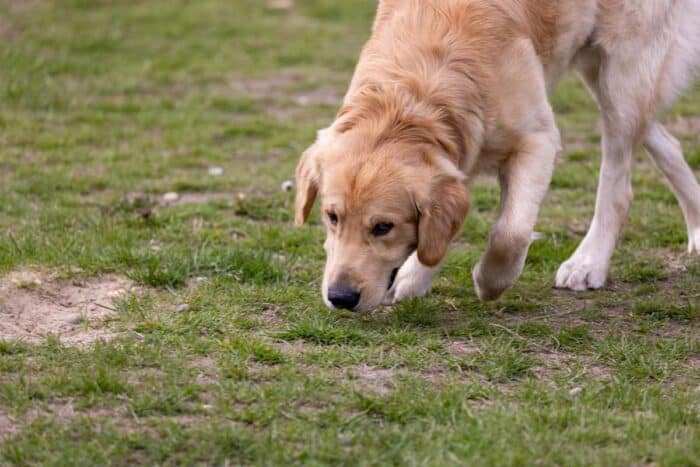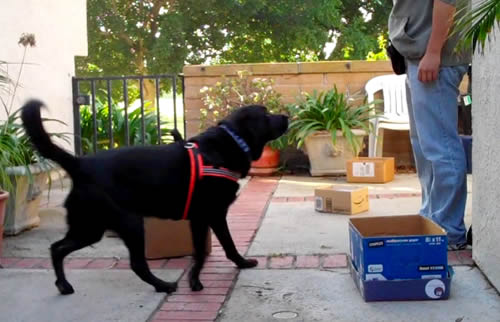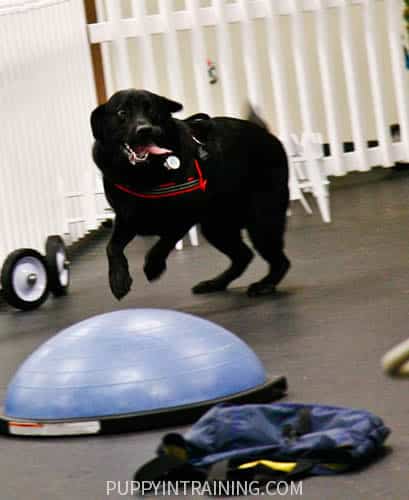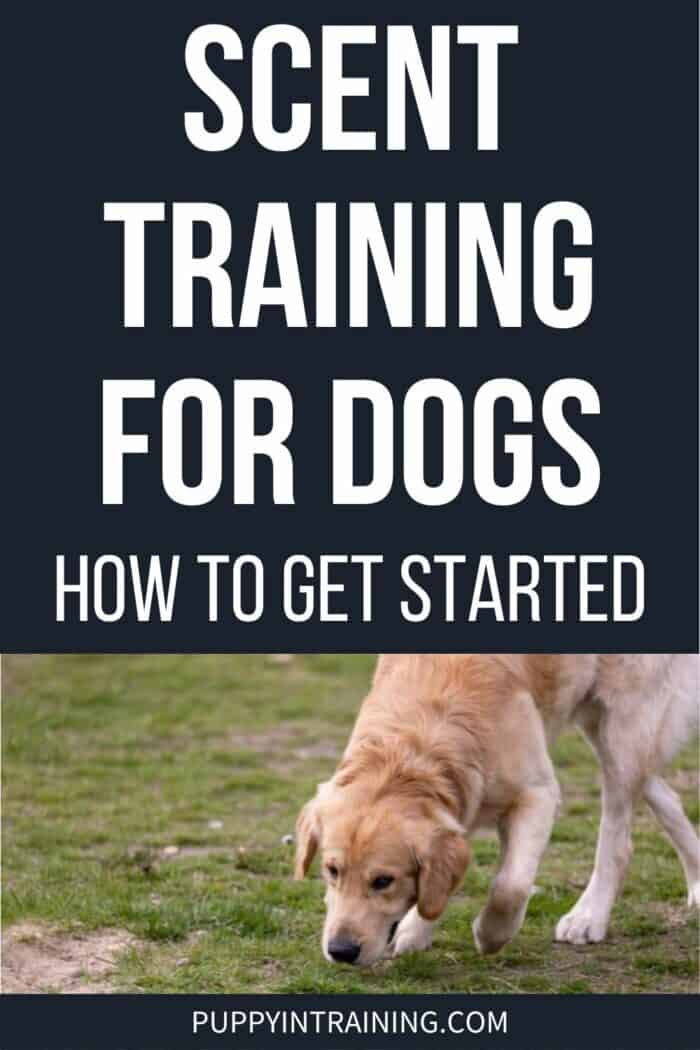Scent Training For Dogs – How To Get Started
This post may contain affiliate links. We may earn money or products from the companies mentioned in this post.
Dogs have an extremely powerful sense of smell that is about 100,000x more powerful than that of humans.
They can detect the equivalent of half a teaspoon of sugar in an Olympic-sized swimming pool.
While dogs have a naturally good sense of smell, if you want them to seek out a specific smell you need to look into scent training for dogs.
Scent Work For Dogs = Nose Work For Dogs
This activity is also sometimes called nose work. Some dogs will undertake scent training for professional purposes, such as detecting illegal substances or tracing missing individuals.

Many will also learn nose work as a skill that they can show off at dog shows.
Scent training your dog at home can be a rewarding experience in its own right.
It can be a form of play and enrichment, as well as mental stimulation for intelligent dogs that get bored.
It can also be an important bonding experience for you and your pup that lets you build trust and a sense of teamwork.
How can you scent train your dog at home and develop their nose work skills?
Read on as we take you through how to start scent training with your dog and the benefits of engaging in this kind of work.
Basic Scent Training
While you can find trainers who specialize in scent work, it is not challenging to scent train your dog at home.
There are also plenty of resources online to guide you through the process. A good place to start is the National Association of Canine Scent Work.
To get started with basic scent work, you don’t need any special equipment, just some smelly dog treats that your pup will enjoy.
You can try the following three basic exercises.
Make sure they have a good grasp of the basic commands such as sit, leave it, and so forth before starting as you will want to be able to control your dog in this way during training.
Need help?
Read our guide to how to teach your puppy to drop it.
Box Search
In this activity, you will want your dog to be able to detect a treat within a series of empty boxes.
This is a great one to do after Christmas when you have lots of empty boxes in the house.
Speaking of holidays, during Easter week, when we were doing K9 Nosework with Stetson he had to find the plastic egg that contained odor. There were about a 100 eggs and only one had odor.
Before you get started, you should introduce your dog to the scent of the treats that you will use.
This can be done simply by holding the treat in your hand, letting them smell it for a few seconds without giving it to them, then handing over the treat.

You can do this in the days leading up to your first proper training exercise.
With your dog out of the room, organize a series of empty boxes on the floor and then place treats in one or some of the boxes.
Lead your dog into the room and prompt them to search for the treat.
You will probably need to show them how to do it a few times first. Show them the treat, but don’t give it to them.
Then lead them to the box that contains the treat and show them how you would like them to indicate the presence of the treat, whether that be a bark, placing their paw on top of the box, or another action.
Open the box, praise them, and give them the reward.
Once they understand how the game works, you can prompt them to do this on their own. Always praise them when they are successful and let them eat the treat.
Muffin Tin Puzzle
Now that they have mastered scent work on a larger scale, you can move down to a smaller scale.
Rather than using boxes, use a muffin tin and place treats in a few of the holders. Then cover all the muffin holders with tennis balls.
Give your dog the command to search for the treats (in our K9 Nosework class we used the command, “FIND IT”) and let them explore the tin and then indicate where they think the treats are.
If they are successful, praise them for their work and let them enjoy their treat.
Shell Game
The three-cup game looks very much like the three-cup magic trick where people try to detect which cup is covering a small ball, which, of course, turns out to be none of them.
You don’t want to trick your dog, though. You want to teach them to use their nose to find their treat.
Start with just one cup, and place the treat underneath it. Teach your dog to paw the cup to indicate the presence of the treat, and then give it to them as a reward.
You can then add the two additional cups with no treats and show your pup that only one of the cups contains what they are looking for.
Let them identify the cup that has the treat.
Once they have mastered this stage, it is time to shuffle the cups and then get them to use their nose to determine which cup contains the treat.
Competition Scent Training
If your dog masters these basic scent training activities, they may have what it takes to learn the kind of formal scent training that often forms part of competitions.
For this, you will need a scent training kit. You can buy these complete online or put your own together.
Can you believe we started K9 Nosework with Stetson over 13 years ago?!? I don’t remember anyone having these fancy scent training kits.
Your scent training kit should contain:
- Cotton swabs
- Essential oils (birch, anise, clove, cypress)
- Mini mason jars to store cotton swabs
- Mini metal tins with holes in the lid
- Tweezers
- Leash or harness
- Carrying case
The essential oils included in the kit are the scents they will be challenged to detect if they participate in competitions, but these require a certain level of care.
The three odors your scent kit should contain are:
- Birch
- Anise
- Clove
For example, they can be toxic to your dog if the oils come in direct contact with their skin.
Make sure your dog doesn’t touch the oils directly, and use gloves and tweezers when handling the oils so you don’t accidentally transfer the oils from your hands to your dog.
When you use the oils, you should place the oils on the cotton swabs and then place those in the metal tins so your dog can detect the smell without touching the swab.
You can then do a variety of activities with these scents, including the three listed in the basic scent training section above.
The next level is to hide the tin somewhere and challenge your dog to sniff it out, rewarding them with a treat every time they are successful.
Sessions should last no more than 10 to 15 minutes and could be shorter if your dog seems to be getting bored.
You want scent work to feel fun and not like a chore. Also, make sure you provide lots of water during scent work. Lots of sniffing can actually lead to dehydration.
Scent Work Competitions
If your dog develops a genuine talent for scent work, there are various competitions organized by the American Kennel Club in which they can participate as a next step.
To be eligible, your dog must be registered with the AKC, even if they are mixed breed, in which case they should have an AKC Canine Partners number.
In competition, there are two divisions. The first is the Odor Search division, which challenges your dog to detect the odor of one or more essential oils.
The second division is the Handler Discrimination division, in which the dog must search for the scent of their handler.
Each division has four different difficulty levels: novice, advanced, excellent, and master.
You can find listings for more than 20,000 dog events, including scent work competitions, here.
Benefits Of Scent Training
Aside from preparing your dog for a competition, if that is something that you are interested in, there are lots of benefits associated with scent training for dogs.
Play And Excitement
While your dog might seem happy to split their day between flopping around in the house and chasing their own tail at the park, dogs do need more forms of entertainment to keep them mentally healthy.
While we might call it “nose work,” it is actually a lot of fun for your pup.
They get to spend time with you, they are challenged to do something difficult but within their skill set, and they are rewarded when they get it right. That all translates into a fun game.
You will probably find that your dog seems more content if they engage in regular scent training, as well as other forms of challenging training.
Mental Stimulation
Dogs require mental stimulation. One of the main reasons dogs get destructive when they are left at home alone is that they are bored!
They need mental stimulation to keep them grounded and relaxed.
A bout of nose work can provide them some mental stimulation before you go out, to help them stay more tranquil in the following hours.
We did K9 Nosework with Stetson and Elsa. I can tell you from my experience that during our 1 hour group sessions our dogs only did 2-3 trainings of about 5 minutes each.
These trainings were so mentally training both Stetson and Elsa were always knocked out for the night.

Improve Your Relationship
Scent work is also a good way to bond with your dog, and not just because you are spending time together.
When completing scent work, you work as a team and they learn to listen to you and trust you when engaging in activities.
While they should already have a good grasp of the basic commands before you start scent training, nose work teaches them more complex and dynamic commands.
Use Their Full Potential
We all want to live up to our full potential, and your dog also has that innate need. They need to run, jump, and maybe hunt and herd, depending on the breed.
Making the most of their nose is another natural canine instinct, and this can help them achieve that within the environment of the home.
Stetson was always a calm and quiet dog but when it came to scent training he was uber excited.
One time when searching for odor he caught the scent so suddenly he did an endo onto his front two legs! It’s one of my most memorable memories of my sill black Lab.
FAQs
Is scent training good for dogs?
Yes, scent training is an excellent form of mental stimulation for dogs and can be a great form of play.
The teamwork required can also help strengthen the bond and trust between the two of you.
How do you start scent training a dog?
You can start scent training your dog at home by teaching your dog to find treats in increasingly complex situations, hiding them in empty boxes and similar locations.
You can teach them the command to search for a scent, how to indicate that they have found the scent, and then reward them with a treat for their hard work.
If they master these basic skills, you can move on to tracking essential oils, which are the scents they are most often challenged to track in competitions.
What scents do dogs use for scent training?
In competitions, the scents used for tracking are birch, anise, clove, and cypress oils. In other countries, different scents may be used, such as wintergreen oil and lemongrass.
At what age can you start scent training a puppy?
A puppy is ready to start scent training as early as eight weeks, but you should be extra careful about not letting their young puppy skin come into contact with any essential oils.
Your puppy should have a good grasp of basic commands before starting scent training.
Start Scent Training Your Dog
Providing your dog with basic scent training can be simple, fun, and highly rewarding.
If you aren’t planning on entering them in competitions, you don’t need anything beyond their favorite treats and things that you have around your home to create hiding spots.
If you do decide to get more serious about scent training for your dog then I highly recommend searching out a good, qualified nosework trainer.
It makes a world of difference having a knowledgable trainer teach you the ins and outs of K9 Nosework.
This is a fun bonding exercise that will help keep them mentally stimulated.
If your dog develops a real skill or passion for scent work, then you can take things to the next level and start training them for competitions, which involves finding specific essential oil scents.
There are then thousands of competitions each year that you can enter as a team.
Remember that every treat you give your dog contains calories and not to spoil their dinner with too many! Read our guide to the best dog foods, treats, and toys.
Related Articles:
Save To Pinterest

Top Picks For Our Puppies
- BEST DOG CHEW
We Like: Beef Collagen Sticks - All of our pups love to bite, nip, and chew. We love using Collagen Sticks to help divert these unwanted behaviors. - BEST PUPPY TOY
We Like: Calmeroos Puppy Toy w/ Heartbeat and Heat Packs - Perfect for new puppies. Helps ease anxiety in their new home. - BEST DOG TREATS
We Like: Crazy Dog Train-Me Treats - We use these as our high-value treats for our guide dog puppies. - BEST FRESH DOG FOOD
We Like: The Farmer's Dog - A couple months ago we started feeding Raven fresh dog food and she loves it! Get 50% off your first order of The Farmer's Dog.
Check out more of our favorites on our New Puppy Checklist.